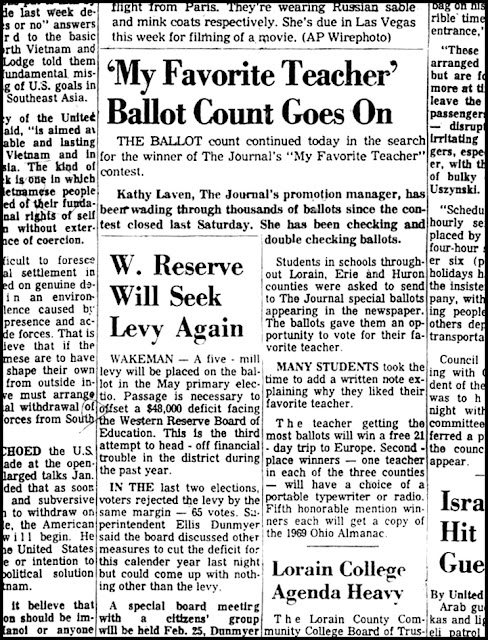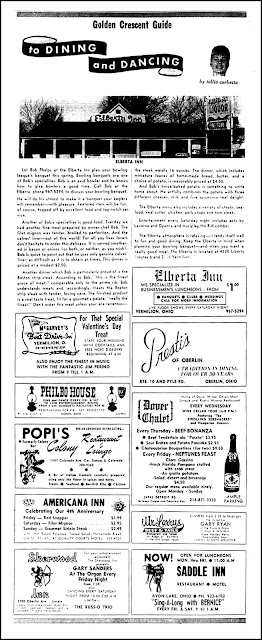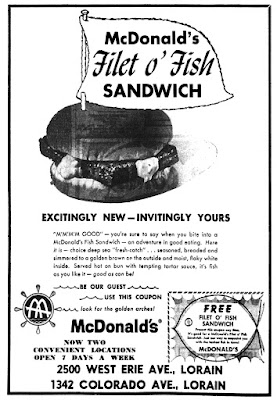Here’s a great article profiling Lorain’s Puerto Rican population that appeared in the Lorain
Journal on Sunday, February 23, 1969. Written by Staff Writer
Jay Maeder, it provides a short history of how U. S. Steel recruited Puerto Ricans in 1947, as well as a look at how the Puerto Rican community was faring in the city in 1969.
****
Puerto Ricans: How Is Their Life in Lorain
By JAY MAEDER
Staff Writer
During a recent session of the Lorain Chamber of Commerce’s Town Talk Forum, someone observed that there wasn’t a minority group member present.
Louis Sanchez got to his feet. “Excuse me,” he said politely. “I’m here.”
Sanchez, a longtime U. S. Steel executive who holds a master’s degree from the Massachusetts Institute of Technology, may not be fully representative of Lorain’s Puerto Rican community, but he shares a common heritage with 10,000 other men and women who have made Lorain their home.
HE WAS HERE long before United States Steel began to import Puerto Rican labor en masse in 1947. That decision handily resolved National Tube’s pressing work-force turnover problem, and the Puerto Rican government was happy to cooperate.
And so they left sunny Puerto Rico and came to Lorain: handsome, dark men; petite, delicately-featured women; mothers and fathers, and children. They came to find opportunity in Lorain, in a city where sometimes the sun was unable to pierce the orange clouds from the Open Hearth.
Now, a new generation of Puerto Ricans live in Lorain. Many of them have never seen the land of their fathers. Many of the original contingent are still here. They will remain the rest of their lives.
WHAT KIND of life has it been for them? What kind of life will it be for their children?
They are a proud and happy people. They have a desire to succeed. United States Steel knows they are hard workers and have made the company’s decision of 1947 a good one.
Some of the older people still speak primarily in Spanish. Many adults try to learn English and try to get further schooling.
In Lorain schools, for instance, 100 of the 165 persons enrolled in the Adult Basic Education courses are Puerto Ricans. The dropout rate is low among Puerto Rican high school students. Last fall Puerto Rican students made up one percent of the enrollment of Lorain County Community College.
TIMOTHY PARRILLA of 1562 E. 32nd Court, Lorain, was one of those who flew to Lorain in 1947 to work in the mill. Like many of the men, he left his family behind. By 1950 he was able to send for them. By 1952 they were able to buy the home in which they now live.
Mrs. Parrilla recalls the sadness of leaving Puerto Rico. But she says a good wife must follow her husband.
“To me,” she says, “It was more important to be with my husband. He had found work here and he was doing his best to provide for us.”
ROBERT CARRERO, who operates Robert’s Dry Goods at 2934 Vine Ave., came to Lorain in 1948 after a year working on a New Jersey farm. He came to American “expecting to kick up $20 bills with my shoe.”
It wasn’t quite that way. Robert, bolstered by a smattering of English he’d picked up working at a hotel in Puerto Rico, first worked as a bartender here, then for Fruehauf in Avon Lake. He saved his money and for six years has has his own store.
“It was pretty hard for a while,” he admits.
MRS. FELIX BERMUDEZ, 28, of 520 W. 26th St., Lorain, operates a beauty shop that was hit in the recent fire on Pearl Avenue. She came to Lorain when she was seven years old with her parents. Her father has worked in the steel mill for 22 years. She’s proud of her accomplishments and those of her people.
“Pride,” she says. “I have lots of it. Especially if you come from another place and make a better life here. That makes you proud.”
Among some of the older Puerto Ricans, the urge to go back to the island is strong. Some return, others speak of it, but stay in Lorain.
ELADIO TORRES, 46, a grocer at 3064 Vine Ave., was drawn to Lorain by a friend’s enthusiastic letter. He got a job at Fruehauf and eventually opened his store.
“I guess it’s easier to make a living here,” he says. “But I love my country. I’d like very much to go back.”
“It is the way of the older ones,” says Isabel Parrilla, daughter of Timothy.
LOIS BIELFELT, executive director of Neighborhood House in Lorain, sums it up this way:
“The older ones, when they speak of Americans, they don’t mean themselves. The younger ones don’t have this confusion.”
For Julio and Felicita Gonzales of 1044 W. 9th St., life has not been easy in Lorain. He has been ill and had to stop working for a while. Welfare checks made it hard for a family of 12 to get along. But Felicita, a proud, hardworking woman, feels that Lorain is best for the family and the children. She is undaunted by their setbacks.
“I tell you the truth, I like it here,” she says. “We don’t have no money, but we’re better off here. I got good friends and neighbors. I’m satisfied.”
EVA SANCHEZ, for 12 years a medical research clerk at St. Joseph Hospital, had been back to Puerto Rico for a visit.
“I feel like a stranger, Puerto Rico has changed so,” she says.
Her husband, Angel, came to Lorain in 1948 and sent for Mrs. Sanchez a year later. He now works as an inspector for the Lorain Ford Assembly Plant.
“It was hard before for the Puerto Ricans to come here,” she says. “But it’s easy now. People have a whole life waiting for them here.”
And they are making their mark in the community, the older early arrivals and their children. They still cling to some of their old customs and culture. You can find Latin gaiety at places like El Hit de Oro at 3014 Vine Ave. There also you’ll find a wall-sized mural depicting Puerto Rico in all its many rural and urban faces.
But on the opposite wall, hung with loving care, is a portrait of John F. Kennedy and the American flag.
****
It would be interesting for the
Morning Journal to do an update of the above article, 50 years later. With the lack of opportunity to make a living work at the steel mill, and the closing of Lorain’s Ford plant, how have the succeeding generations of Puerto Ricans fared?
Have many returned to the island home of their fathers?
Even Vine Avenue’s once vibrant business district is gone, with the most of the street vacated with no evidence of the cultural importance it once had.






















































